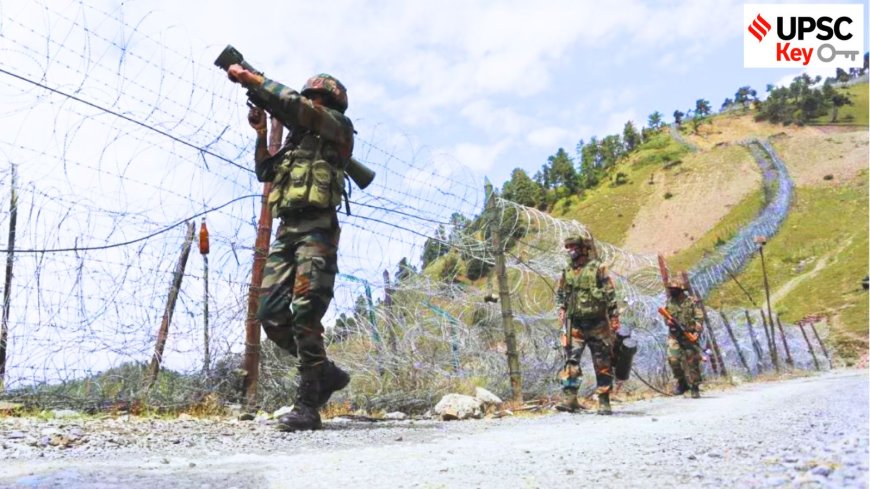UPSC Key: Line of Control, Bagram airfield and US-China tariff talks

UPSC Key: Line of Control, Bagram airfield and US-China tariff talks
Asarkari - Sarkari News, Jobs & Updates
By Priya Sharma
kam sabdo me kahein to, this article breaks down the significance of the Line of Control between India and Pakistan, the strategic implications following the US withdrawal from Bagram Airfield in Afghanistan, and the complex dynamics of US-China tariff talks, all vital current affairs topics for UPSC aspirants.
Introduction: Connecting Key Geopolitical Flashpoints
Understanding contemporary global and regional dynamics is crucial for any Union Public Service Commission (UPSC) aspirant. Recent developments concerning the Line of Control (LoC), the strategic Bagram Airfield in Afghanistan, and the persistent US-China trade tensions are interconnected threads in the complex tapestry of international relations, security challenges, and global economics. These topics frequently feature in UPSC Prelims and Mains exams, particularly in General Studies papers covering International Relations, Security, and Economy. Let's delve deeper into each of these critical areas.
The Line of Control (LoC): More Than Just a Border
The Line of Control refers to the military control line between the Indian and Pakistani controlled parts of the former princely state of Jammu and Kashmir. It's crucial to note that it is *not* an internationally recognized border but serves as a de facto boundary. Its origins lie in the ceasefire line established after the 1947-48 war, which was later formalised and renamed the LoC following the Simla Agreement signed on July 2, 1972, between India and Pakistan.
Historical Context and Significance: The Simla Agreement emphasised resolving differences through peaceful means and bilateral negotiations, making the LoC a symbol of that commitment, albeit a frequently tested one. The LoC stretches approximately 776 kilometers through varied and often difficult terrain.
Recent Developments: While a renewed ceasefire agreement in February 2021 brought relative calm, the LoC remains a sensitive zone prone to infiltration attempts, ceasefire violations, and more recently, concerns over drone activities used for surveillance or smuggling arms and narcotics. Understanding the dynamics here is vital for grasping India-Pakistan relations, cross-border terrorism issues, and internal security challenges – all core UPSC topics. Questions related to the LoC often test knowledge of historical agreements, geographical significance, and current security challenges.
Bagram Airfield: A Strategic Pivot in Afghanistan
Located north of Kabul, Bagram Airfield was the largest US military base in Afghanistan for nearly two decades. Its significance extends far beyond its military role; it was a symbol of the US presence and its operations following the 9/11 attacks.
Historical and Strategic Importance: Originally built by the Soviets in the 1950s and heavily used during their occupation in the 1980s, Bagram became the nerve centre for US and NATO operations after 2001. Its extensive infrastructure, including long runways capable of handling large military aircraft, made it strategically vital.
Post-US Withdrawal Implications: The hasty withdrawal of US forces from Bagram in July 2021, ahead of the complete pullout from Afghanistan, was seen as a pivotal moment preceding the swift Taliban takeover of Kabul in August 2021. The control of Bagram now rests with the Taliban regime. Its future use, potential influence by regional powers like China or Pakistan, and the security vacuum left behind have significant implications for regional stability, particularly concerning counter-terrorism efforts and the geopolitical balance in Central and South Asia. For India, the situation impacts its strategic interests and concerns about terrorism emanating from Afghan soil. This ties directly into UPSC syllabus areas concerning India's neighbourhood policy, regional security architecture, and the impact of global power shifts. For more updates on international developments, visit https://asarkari.com.
US-China Tariff Talks: The Global Economic Chessboard
The trade relationship between the world's two largest economies, the United States and China, has been fraught with tension, primarily manifested through tariffs imposed by both sides since 2018. These are essentially taxes levied on imported goods, designed to make them more expensive and theoretically protect domestic industries.
Background and Key Issues: The conflict stems from US concerns over its large trade deficit with China, allegations of unfair trade practices, intellectual property theft, forced technology transfers, and lack of market access for American companies in China. China, in turn, has retaliated with its own tariffs and accused the US of protectionism and attempting to curb its economic rise.
Ongoing Dynamics and Global Impact: While talks have occurred intermittently, leading to phased agreements like the "Phase One" deal, fundamental disagreements persist. The ongoing tensions create uncertainty in global supply chains, impact international trade volumes, and influence global economic growth. For India, the US-China trade friction presents both challenges (potential disruption in supply chains, collateral impact on exports) and opportunities (trade diversion, attracting manufacturing relocating from China). Understanding tariffs, trade deficits, WTO mechanisms, and the geopolitical dimensions of economic conflict is essential for the UPSC Economics and International Relations syllabus.
Conclusion: Integrating Knowledge for UPSC Success
The Line of Control, Bagram Airfield, and US-China tariff talks are not isolated events. They represent critical intersections of geopolitics, security, and economics. For UPSC aspirants, dissecting these issues involves understanding their historical roots, current status, key players involved, and most importantly, their implications for India's foreign policy, security, and economic interests. Maintaining a consistent study of such current affairs, analyzing them from multiple perspectives, and linking them to the core syllabus is key to success in the civil services examination.
- Team Asarkari
Keywords
Line of Control India Pakistan, LoC UPSC, Simla Agreement 1972, Bagram Airfield Afghanistan, US withdrawal Afghanistan implications, Taliban Bagram base, US China trade war UPSC, US China tariff talks summary, global economic impact trade war, international relations current affairs UPSC, India Pakistan relations UPSC, Afghanistan regional security, UPSC GS Paper 2, UPSC GS Paper 3What's Your Reaction?
 Like
0
Like
0
 Dislike
0
Dislike
0
 Love
0
Love
0
 Funny
0
Funny
0
 Angry
0
Angry
0
 Sad
0
Sad
0
 Wow
0
Wow
0








































